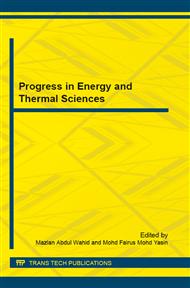[1]
Kadir M, Misbah N, Gomes C, Jasni J, Wan Ahmad W, Hassan M. Recent statistics on lightning fatalities in Malaysia. Lightning Protection (ICLP), 2012 International Conference on: IEEE; 2012. pp.1-5.
DOI: 10.1109/iclp.2012.6344337
Google Scholar
[2]
Yahaya M, Abdullah N. The Implementation and Use of the LLP Lightning Detection Network (LDN) in Malaysia: TNBR Experience. Heads of ASEAN Power Utility Association (HAPUA) 13th Meeting on Cooperation Projects in Research, Development & Engineering2003. pp.16-8.
Google Scholar
[3]
Krider EP, Noggle RC, Uman MA. A gated, wideband magnetic direction finder for lightning return strokes. Journal of Applied Meteorology. 1976; 15: 301-6.
DOI: 10.1175/1520-0450(1976)015<0301:agwmdf>2.0.co;2
Google Scholar
[4]
Ahmad H, Yahya MP, Alam MA. LIGHTNING DETECTION SYSTEM IN MALAYSIA. (1995).
Google Scholar
[5]
Yahaya M, Zain S. Characteristics of Cloud to Ground Lightning in Malaysia. Conference on Lightning Protection and Earthing Systems, Kuala Lumpur, Malaysia (2000).
Google Scholar
[6]
Cummins KL, Murphy MJ, Bardo EA, Hiscox WL, Pyle RB, Pifer AE. A combined TOA/MDF technology upgrade of the US National Lightning Detection Network. Journal of Geophysical Research: Atmospheres (1984–2012). 1998; 103: 9035-44.
DOI: 10.1029/98jd00153
Google Scholar
[7]
Abdullah N, Hatta NM. Cloud-to-ground lightning occurrences in Peninsular Malaysia and its use in improvement of distribution line lightning performances. Power and Energy (PECon), 2012 IEEE International Conference on2012. pp.819-22.
DOI: 10.1109/pecon.2012.6450330
Google Scholar
[8]
Abdullah N, Yahaya MP, Hudi NS. Implementation and use of lightning detection network in Malaysia. Power and Energy Conference, 2008 PECon 2008 IEEE 2nd International: IEEE; 2008. pp.383-6.
DOI: 10.1109/pecon.2008.4762504
Google Scholar
[9]
Uman MA. The lightning discharge: Courier Dover Publications; (2012).
Google Scholar
[10]
Rakov V. A Review of Positive and Bipolar Lightning Discharges. Bulletin of the American Meteorological Society. 2003; 84.
DOI: 10.1175/bams-84-6-767
Google Scholar
[11]
Cooray V, Lundquist S. On the characteristics of some radiation fields from lightning and their possible origin in positive ground flashes. Journal of Geophysical Research: Oceans (1978–2012). 1982; 87: 11203-14.
DOI: 10.1029/jc087ic13p11203
Google Scholar
[12]
Schumann C, Saba M. Continuing current intensity in positive ground flashes. Lightning Protection (ICLP), 2012 International Conference on: IEEE; 2012. pp.1-5.
DOI: 10.1109/iclp.2012.6344260
Google Scholar
[13]
Romero C, Rachidi F, Rubinstein M, Paolone M, Rakov VA, Pavanello D. Positive lightning flashes recorded on the Säntis tower from May 2010 to January 2012. Journal of Geophysical Research: Atmospheres. 2013; 118: 12, 879-12, 92.
DOI: 10.1002/2013jd020242
Google Scholar
[14]
Yahya MP. lightning phenomena in Malaysia. seminar for ARSEPE2007.
Google Scholar
[15]
Petersen WA, Rutledge SA. Some characteristics of cloud‐to‐ground lightning in tropical northern Australia. Journal of Geophysical Research: Atmospheres (1984–2012). 1992; 97: 11553-60.
DOI: 10.1029/92jd00798
Google Scholar
[16]
Hidayat S, Ishii M, Hojo J, Sirait K, Pakpahan P. Observation of lightning in Indonesia by magnetic direction-finder network. Proceedings of the 10th International Conference on Atmospheric Electricity, Osaka, Japan1996.
Google Scholar
[17]
Whitehead JT, Chisholm WA, Anderson J, Clayton R, Elahi H, Eriksson A, et al. IEEE working group report. Estimating lightning performance of transmission lines. II: Updates to analytical models. IEEE transactions on power delivery. 1993; 8: 1254-67.
DOI: 10.1109/61.252651
Google Scholar
[18]
Paolone M, Rachidi-Haeri F, Nucci CA. IEEE Guide for Improving the Lightning Performance of Electric Power Overhead Distribution Lines. IEEE.
DOI: 10.1109/ieeestd.2011.5706451
Google Scholar
[19]
Wooi C, Abdul-Malek Z, Mashak SV. Effect of Ambient Temperature on Leakage Current of Gapless Metal Oxide Surge Arrester. Jurnal Teknologi. 2013; 64.
DOI: 10.11113/jt.v64.2119
Google Scholar
[20]
Wooi CL, Abdul-Malek Z, Mashak SV. Implementation of Wireless Thermal Camera Remote Control System. Applied Mechanics and Materials: Trans Tech Publ; 2014. pp.561-5.
DOI: 10.4028/www.scientific.net/amm.554.561
Google Scholar


